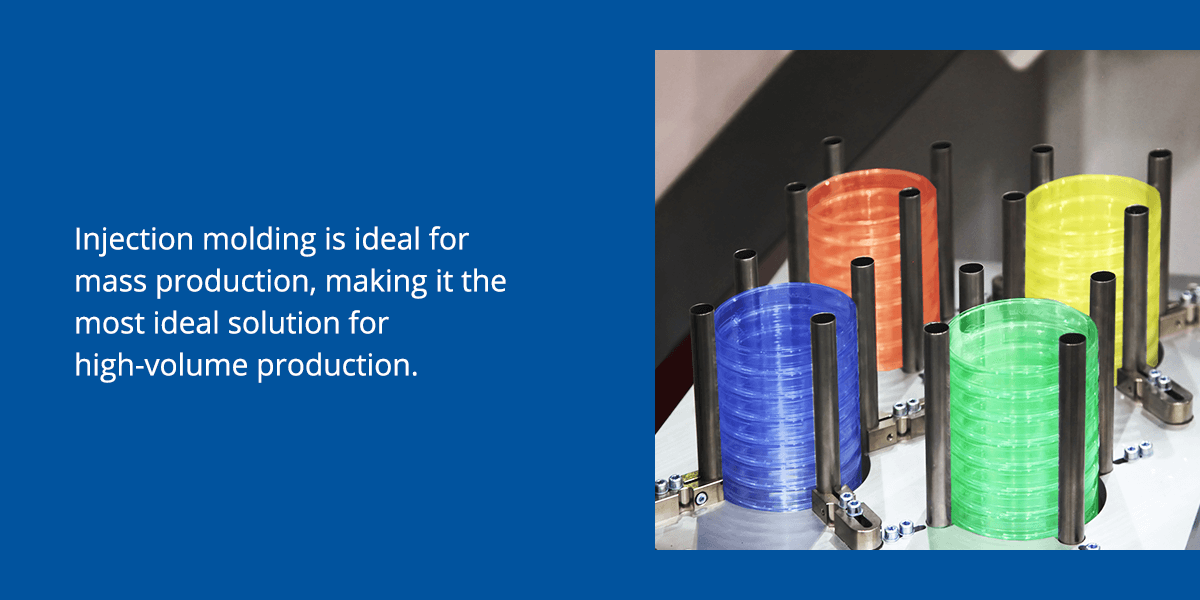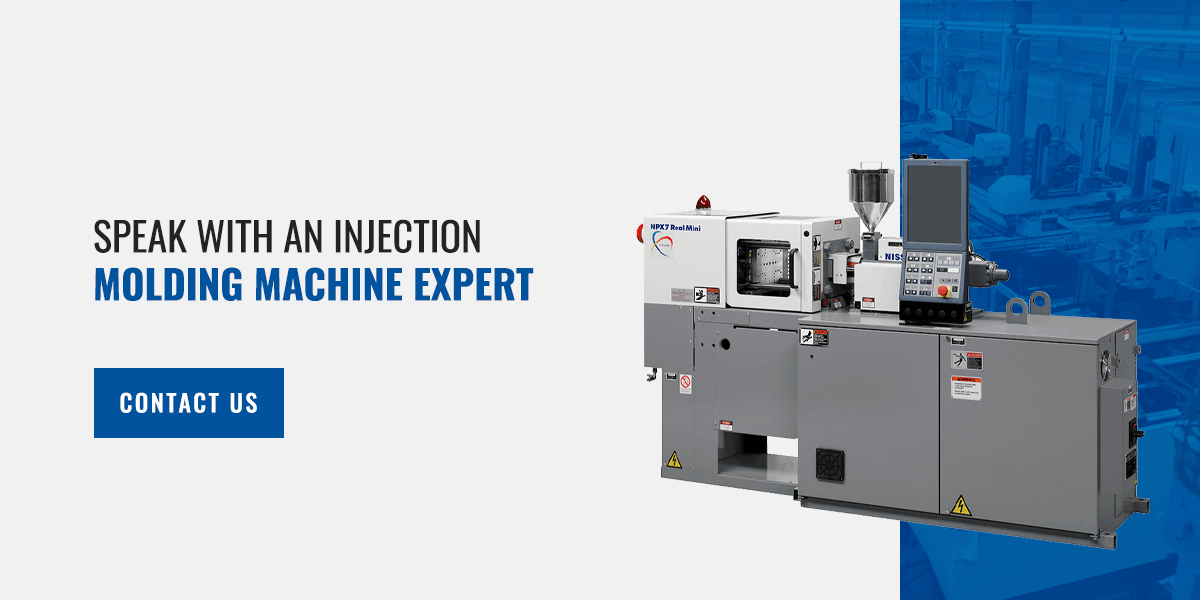3D printing and injection molding involve two different manufacturing processes. However, both are complementary methods to help you create parts for your specific application and industry. There are advantages and disadvantages to each when it comes to production times and output rates.
The Rise of 3D Printing
3D printing technology is an additive method that builds a product one layer at a time. Also known as additive manufacturing, 3D printing has risen in accessibility and become available to the average person over the past decade. In an industrial setting, 3D printing supports multiple applications, such as:
- Small batches of products
- Intricate and delicate designs with holes
- Prototyping
Overall, additive manufacturing is a precise and tedious process that operates via programs like computer-aided design (CAD) and other applications.
3D Printing Advantages
When it comes to 3D printing vs. injection molding, both are advantageous for different reasons. For example, the benefits of working with a 3D printer include:
1. More Cost-Effective for Low-Volume Projects
A 3D printer, including its computer programs and materials for generation, is more cost-effective than the industrial injection molding process. On top of their low entry costs, 3D printers are faster to set up because they don’t require molds. This method is a cost-effective way to produce low-volume projects.
2. Easier to Make Prototype Design Changes
One of the biggest advantages of working with a 3D printer is that it supports prototypes and multiple design changes that result in a final product. If you’re working on new components where design changes are frequent, using a 3D printer is your go-to, as you can make alterations to a part during the printing process.
For example, you can pause production, make changes within the software and then continue. In comparison, using the injection process would require you to make a mold, create the product and go back and forth to modify and test until you reach the perfect design
Being able to alter a test model saves you time, money and material, which you can’t get when restarting from scratch. Once you’ve perfected the design, you can use an injection molding machine to create multiple at a time. 3D printing is a type of production that’s also great for one-off products.
Because 3D printing allows you to test and adjust components quickly at a more cost-effective rate, it complements the injection molding technique. Once you have a product with the right design, you can move to injection molding to create many final products.
3. Ideal for Small or Intricate Pieces
Finally, a 3D printing machine supports complex and small designs because of the machine’s precision. If you’re looking to make intricate parts with holes, right angles and more delicate aspects, 3D printing is your best bet.
3D Printing Disadvantages
A few downfalls of using a 3D printer compared to an injection molding machine include:
1. Slow Production Rates
Production time requirements to produce a single product using 3D printing are much more substantial than the injection molding process. Some machines can take up to two hours to create one component. There are more advanced versions that can be a bit faster, but they’re by no means as efficient as the molding process.
2. Low-Volume Output
This also causes a limit on how many parts the 3D printer can produce at a time. These units can only produce one or two pieces at a time, while injection molding machines can hold several molds at once for mass production. 3D printers take much more time to create one product and more money when you’re looking to produce many of the same pieces.
3. Supports Only Smaller Products
The size of product you wish to make is also limited by the size of the 3D printing area. Although it’s possible to create larger items, parts that print outside the space can make the design unstable, so big objects aren’t a 3D printer’s strong suit.
4. Rough Finishes
3D printing is extremely precise, but because of the building and layering technique, final products often have rougher finishes. If necessary, you may need to smooth the parts down.
Injection Molding 101
An industrial injection molding machine is a two-part system that includes the injection unit and mold. The injection unit melts and injects the plastic or other molten material into a two-sided mold, which clamps together before the injection begins. Once the plastic parts cool, the clamping mechanism opens again and ejects the finished product, then the process starts over.
It’s a simple, straightforward process in which a machine can hold several molds at once to produce multiple products at the same time. The main applications of injection molding include:
- Large batches of products
- Strong components
- Smooth finishes
Contact Us For Your Injection Molding Needs
Injection Molding Advantages
Because injection molding is an automated process for when you have a final blueprint, it can result in many benefits, such as:
1. Fast Production Rates
For injection molding, production times are much faster compared to 3D printers. With an injection molding machine, injection times range from several seconds to several minutes. This means that it’s typically not used for single-part production.
Instead, injection molding is ideal for mass production. This can mean hundreds or thousands of the same part are produced within several weeks, making it the most ideal solution for high-volume production.
2. Strong Final Products
3D printing vs. injection molding strength differs. 3D printers can produce intricate and delicate products while injection processes use a single insert of poured material into the mold, resulting in a strong component without any areas of weakness.
Injection Molding Disadvantages
One of the main questions is 3D printing vs. injection molding cost. While injection molding showcases incredible benefits, several disadvantages include:
1. Higher Upfront Investment
Injection molding technology includes the use of an industrial machine, mold design and materials, making it a costly upfront investment. Unlike 3D printers, these machines aren’t found anywhere else except a proper site. However, when you produce high volumes of components for your application, it can even out in the long run.
2. Fewer Design Capabilities
While injection molding machines can make small detailed pieces like a 3D printer, there are some designs the machine struggles with. For example, more delicate objects aren’t ideal, and components with right angles in the blueprint are more likely to break during removal.
3. Difficult to Make Design Changes
Injection molding isn’t the best option when you have a prototype and you’re looking to make adjustments during the process. Molding machines have long setup times that can be expensive to modify each time you want to make a change. The mold will also need to be remade so that you can fix any issues, then the process starts over.
Speak With an Injection Molding Machine Expert
Plasti-Co is your go-to partner for aftermarket solutions. If you’re unsure whether injection molding or 3D printing is the best fit for your needs, our experts can assist — we’re here to help you design and create products that match your exact specifications while increasing productivity and minimizing downtime.
Whether you need pieces for a new invention, components to manufacture a vehicle or products for medical use, our engineers have the skillsets to meet your needs. Plasti-Co is a service-oriented operation that takes time to understand your application and determine the best steps forward.
Contact our team for a quote and learn how you can partner with us for injection molding solutions.


